► Japanese
Discover Our Origin from Remnants of Stars
1. Birth and Death of Stars
Stars are born and die like us. Stars live various years to their ends.
Generally, the life span of each star varies from several million years to ten billion years.
Our sun is now five billion years old. So, the sun is going to die in five billion years.
Some stars go up stellar explosions at the end. The explosion is very huge. The explosion may happen
to be seen by the naked eye on the earth, even if it occurs at the point several thousand light years
away. Since it seems as if a new star appears, it is called the Nova. We call that stellar
explosion the Supernova Explosion. The remnant of the Supernova Explosion is a shell of
gas expanding at a velocity of several thousand kilometers per second. The remnant is a stellar corpse
so called the Supernova Remnant. The gas expansion of the Supernova Explosion continues
for about twenty to thirty thousand years. The gas expands to the size that is as large as it may swallow
the next star. That is like a end of the world.
Let's study what happens in such a stellar explosion.
2. Tycho's Nova
Tycho Brahe (1546-1601), was a Danish astronomer. He discovered a very bright star in 1572. The star
had newly appeared in the constellation Cassiopeia. As this star had appeared unexpectedly, he named it
Tycho's Nova. The apparent magnitude of the star became as bright as -2.5 (m) at the brightest. It
is very bright, since the brightest star of the celestial sphere is Sirius whose apparent magnitude is -1.5 (m).
Tycho's Nova had been getting dark. It finally disappeared 14 months later.
3. Suzaku Observed Tycho's Nova.
430 years have already passed since the explosion occurred. Tycho's Nova is invisible to the naked eye today.
But, it still radiates the X-ray and is shining now. In 2006, Japanese X-ray observation satellite Suzaku observed
the location of Tycho's Nova. Let's study the data.
3.1. Let's Download the data
Let's download the Tycho's Nova data file, tycho.fits.
Using the right click button on your mouse, put a name on the tycho.fits file, and store it.
3.2. Let's See the Image.
Let's see the image, making use of "ds9". Enable "ds9". Then, click "File" and "open" to open
the "tycho.fits" file. You can see the better image at 1/2 of "zoom" after you click "zoom".
3.2.1. What structure can you see?
(Clue to the answer: In the image size, the angle for one side is 0.3 degrees.)
It is found that the distance from here to Tycho's Nova is 6000 light years.
(One light year is equal to 10 trillion km)
The age of Tycho's Nova is 430 year old.
3.3. Let's Study the X-ray Colors Radiated from Tycho's Nova.
Let's make use of "fv", and study what energy of X-ray comes here abundantly from Tycho's Nova.
Enable "fv". Then, choosing "File open", open "tycho.fits".

On the lower column of the "Display" part, click "frequency distribution" located second from left.
Choose "X=energy" on the newly displayed window. Leave "Y" field empty. Clicking "Make Plot", you can get
a plot showing what energy of X-ray is abundant.
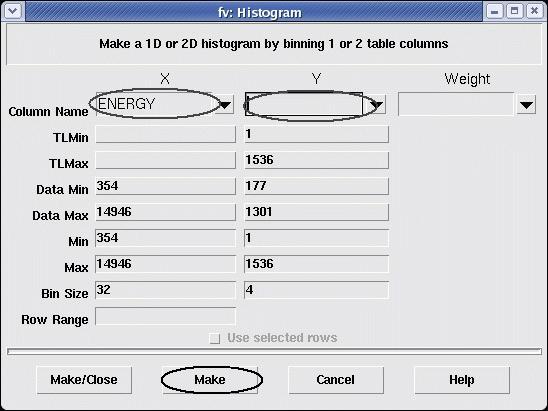 If the maximum value and the minimum value are rewritten, an enlarged plot will be displayed.
If the maximum value and the minimum value are rewritten, an enlarged plot will be displayed.
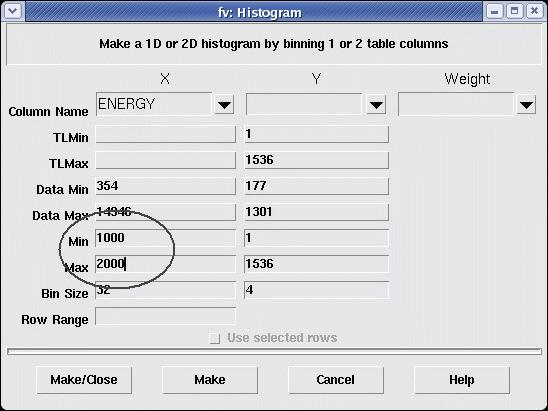
3.4. The X-ray and Elements from Tycho's Nova
The X-ray from Tycho's Nova is the light of the plasma. The temperature of the plasma is
several million degrees centigrade. The X-ray shines brightly in special bandwidth is called
the characteristic X-ray. The characteristic X-ray means that the X-ray radiated from
the specific element has the identical energy or same color. This resembles the Flame Test.
If the hydrogen atom is heated to several million degrees centigrade, the energy of the characteristic
X-ray is 10.2 electron volt. The energy of the characteristic X-ray is proportional to the square
of the atomic number Z.
(clue to the answer: The elements whose atomic number Z are even
numbers, abound in Tycho's Nova.)
Let's use the atomic number Z and the periodic table to find the element shining in Tycho's Nova.
4. Our Origin: Death of a Star
The human body is made from elements such as carbon, oxygen, and etc.
The human bone includes calcium, and the human blood includes iron.
What is an element here ? The element is the same element as that you found in Tycho's Nova.
When the universe was born 13.7 billion years ago, it is said that there did not exist any elements
other than hydrogen, helium, and a small amount of lithium. All the elements other than those having
existed at the birth of the universe, have been produced from hydrogen through the nuclear fusion in
each star. The nuclear fusion powers each star in its life span. The sun is shining and producing new
elements, utilizing its internal nuclear fusion. Those elements produced from the nuclear fusion in a
star is dispersed by the stellar explosion like Tycho's Nova, when the life of a star ends.
So, Tycho's Nova is shining with the characteristic X-rays of the various elements.
The dispersed gases or dusts, including their elements, mass together again in a long time span, and
will become a star and its planets. The life will be born on a planet. We and the sun are said to have
been born after a stellar explosion, which usually happens with the death of star, had dispersed gases
or elements. In a way, we are the star children born on a star.
(Extension)5. Tycho's Nova Viewed from Each Element
Let's see what is going on, if we view Tycho's Nova from each element.
Use "fv" to make a image for every element.
Save data in a name of each element after you divide the energy into the characteristic X-rays
or elements.
5.1. Where is the element in the remnant of a supernova ?
Let's use "ds9" to make a color image of Tycho's Nova.
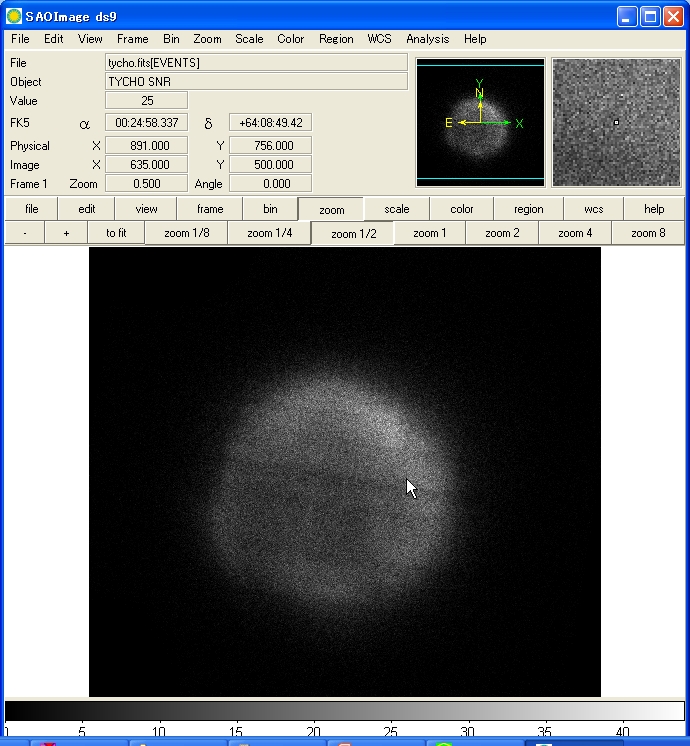
Answer
You can see the object like a bubble, can't you ?
This is the remnant of a Supernova, having been left after the death of a star.
 The diameter is about 0.15 degrees.
Since the distance from here to the celestial body is 6000 light years,
the diameter of the celestial body is given by
The diameter is about 0.15 degrees.
Since the distance from here to the celestial body is 6000 light years,
the diameter of the celestial body is given by
6000 (light years) x sin(0.15 degrees) = 16 (light years)
velocity of shock wave = diameter / unit time
= 8 light years / 430 years
= 8 x 10 trillion km / 430 years = 5900 km / sec.
With this velocity, you can go around the earth in about 7 seconds.
It is extremely fast, isn't it ?
There are several energy or color spots radiating the strong X-ray.
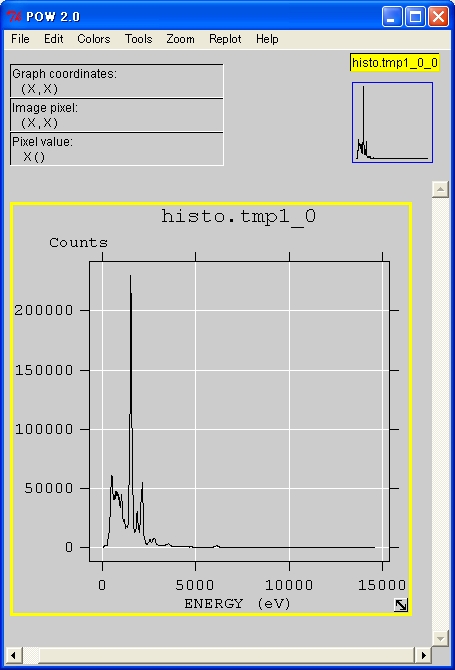
It seems that this stellar explosion is shining in the particular color only.
The unit used for the X-ray energy or the color is the electron volt (eV).
Especially, the energies;
480 eV
670 eV
1000 eV
1300 eV
1500 eV
1850 eV
2100 eV
2500 eV
4500 eV
6700 eV
and etc. are shining brightly.
(Note: All the energies are not written here.)
The relation between the X-ray energy and the atomic number Z is described as follows;
There are some values that are disagreements with the calculations.
Those disagreements come from the atomic structure differences, and so on.
| energy(eV) | atomic number(Z) |
| 480 | 7 |
| 670 | 8 |
| 1000 | 10 |
| 1300 | 12 |
| 1500 | 12 |
| 1850 | 14 |
| 2100 | 14 |
| 2500 | 16 |
| 4500 | 20 |
| 6700 | 26 |
| energy(eV) | atomic number(Z) | element name |
| 480 | 7 | nitrogen (N) |
| 670 | 8 | oxygen (O) |
| 1000 | 10 | neon (Ne) |
| 1300 | 12 | magnesium (Mg) |
| 1500 | 12 | magnesium (Mg) |
| 1850 | 14 | silicon (Si) |
| 2100 | 14 | silicon (Si) |
| 2500 | 16 | sulfur (S) |
| 4500 | 20 | calcium (Ca) |
| 6700 | 26 | iron (Fe) |
3.4.3.
Nitrogen and oxygen exist in the air, neon exists in the fluorescent light, silicon exists
in the rubber or in the computer, magnesium exists in the sea water, calcium exists in
your bones, and iron exists in the buildings or in your blood. Those elements existing
around you, also exist in Tycho's Nova.
5.1.
You can see the element with Larger atomic number Z at the
more internal location of the Supernova remnant. It means that the heavier elements were
abundant in the central part of the star, and that the lighter elements were abundant in the outer
part in the star.
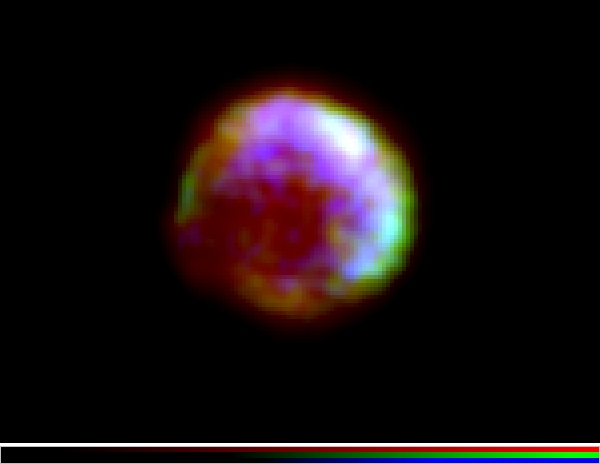
Red is Tycho's Nova image produced by the X-ray from silicon, green is Tycho's Nova image
produced by the X-ray from calcium, and blue is Tycho's Nova image produced by the X-ray from iron.
Making full use of "fv" and "ds9", you can make those Tycho's Nova images. Please try.
